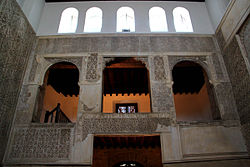
The Ezrat Nashim (Hebrew: עזרת נשים) or Vaybershul (Yiddish: ווײַבערשול), commonly referred to in English as the women's section or women's gallery, is an area of a synagogue sanctuary reserved exclusively for women.
Scholars have long debated the existence of Ezrat Nashim in synagogues during the periods of the Second Temple, the Mishnah, and the Talmud. Shmuel Safrai, through a combination of textual analysis and archaeological evidence, has argued that while women consistently attended synagogue services, there is no definitive evidence to support the existence of a partition separating the genders or the existence of a Ezrat Nashim. The archaeologist Lee Levin agrees with Safrai that not only is there no archaeological evidence for the existence of Ezrat Nashim in ancient synagogues, but there are also many ancient synagogues that have only a single prayer hall, indicating that there was no segregation at all.
The Ezrat Nashim could be either a separate annex, as observed in synagogues like the Altneuschul in Prague and the synagogue of Worms, or an elevated gallery situated within the synagogue sanctuary. If the latter, it is typically located on the west side of the building, though variations exist with some galleries positioned on the north or south sides. In larger synagogues, it is common to find two galleries, one above the other.
In the mid-19th century, Reform synagogues in Germany and Austria introduced separate pews for men and women on the same floor. Later, Reform congregations in the United States introduced "family seating", whereby congregants sit together irrespective of gender. Many Orthodox synagogues built in the 20th and 21st centuries do not have a separate Ezrat Nashim area, instead partitioning a single floor into men's and women's sections with a mechitza.
See also
References
![]() This article incorporates text from a publication now in the public domain: Adler, Cyrus; Deutsch, Gotthard (1903). "Frauenschul or Weiberschul". In Singer, Isidore; et al. (eds.). The Jewish Encyclopedia. Vol. 5. New York: Funk & Wagnalls. p. 501.
This article incorporates text from a publication now in the public domain: Adler, Cyrus; Deutsch, Gotthard (1903). "Frauenschul or Weiberschul". In Singer, Isidore; et al. (eds.). The Jewish Encyclopedia. Vol. 5. New York: Funk & Wagnalls. p. 501.
- Safrai, Shmuel (1983). ארץ ישראל וחכמיה בתקופת המשנה והתלמוד (in Hebrew). Israel: Hakibbutz Hameuchad. pp. 94–104.
- Levine, Lee I. (1991). "From Community Center to 'Lesser Sanctuary': The Furnishings and Interior of the Ancient Synagogue". Cathedra: For the History of Eretz Israel and Its Yishuv (in Hebrew). 60: 48–50. ISSN 0334-4657.
-
 Adler, Cyrus; Eisenstein, Judah David (1903). "Gallery". In Singer, Isidore; et al. (eds.). The Jewish Encyclopedia. Vol. 5. New York: Funk & Wagnalls. p. 555.
Adler, Cyrus; Eisenstein, Judah David (1903). "Gallery". In Singer, Isidore; et al. (eds.). The Jewish Encyclopedia. Vol. 5. New York: Funk & Wagnalls. p. 555.
- Sarna, Jonathan D. (1987). "The Debate Over Mixed Seating in the American Synagogue". In Wertheimer, J. (ed.). The American Synagogue: A Sanctuary Transformed. Cambridge: Cambridge University Press. pp. 363–367.